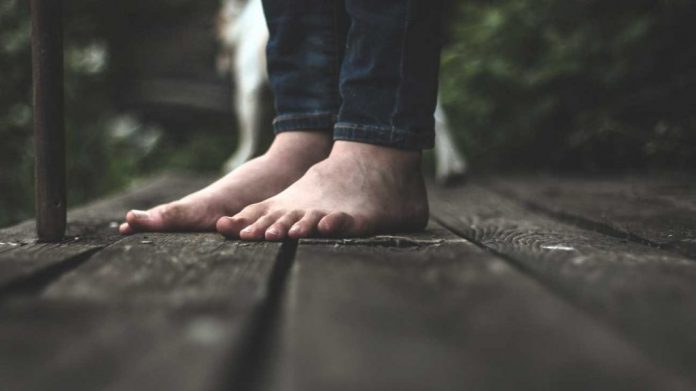Overview
Walking barefoot might be something you only do at home. But for many, walking and exercising barefoot is a practice they do daily.
When a toddler is learning to walk, parents are told to let this process happen naturally, and without shoes. That’s because shoes can affect how a child uses the muscles and bones in their feet.
Kids also receive feedback from the ground when they walk barefoot, and it improves their proprioception (awareness of their body in space).
As a child gets older, we shove their feet into shoes and lose the benefits that come from walking barefoot.
That’s why advocates of barefoot walking and exercising are pushing back on wearing shoes all day long and encouraging all of us to let our feet be free.
“The most straightforward benefit to barefoot walking is that in theory, walking barefoot more closely restores our ‘natural’ walking pattern, also known as our gait,” explains Dr. Jonathan Kaplan, foot and ankle specialist and orthopedic surgeon with Hoag Orthopaedic Institute.
But if you go to any running or walking store and look at several different pairs of shoes, you’ll see that many of them have excessive cushioning and support.
While this pillow-type padding can feel pretty amazing when you walk in these types of shoes, board-certified podiatrist and foot surgeon Dr. Bruce Pinker says they can prevent you from using certain muscle groups that can actually strengthen your body.
Other benefits of walking barefoot include:
- better control of your foot position when it strikes the ground
- improvements in balance, proprioception, and body awareness, which can help with pain relief
- better foot mechanics, which can lead to improved mechanics of the hips, knees, and core
- maintaining appropriate range of motion in your foot and ankle joints as well as adequate strength and stability within your muscles and ligaments
- relief from improperly fitting shoes, which may cause bunions, hammertoes, or other foot deformities
- stronger leg muscles, which support the lower back region
Walking barefoot in your house is relatively safe. But when you head outside, you expose yourself to potential risks that could be dangerous.
“Without appropriate strength in the foot, you are at risk of having poor mechanics of walking, thereby increasing your risk for injury,” explains Kaplan.
This is especially important to consider when you’re beginning to incorporate barefoot walking after having spent much of your life in shoes.
He also says that you need to consider the surface being walked on. While it may be more natural to walk or exercise barefoot, without additional padding from shoes, you are susceptible to injury from the terrain (like rough or wet surfaces or issues with temperature, glass, or other sharp objects on the ground).
You also take the chance of exposing your feet to harmful bacteria or infections when you walk barefoot, especially outside.
Christopher Dietz, DO, MedExpress, says people with diabetes should always consult with their primary care physician before going barefoot. “If they have peripheral neuropathy, they can sustain wounds on the bottom of their feet and not realize it,” he explains.
Knowing how to walk and exercise barefoot takes time, patience, and the right information. So, before you ditch your shoes in favor of a more natural approach to walking and exercise, there are a few things to consider.
- Start slow. You need to be patient and start with short 15- to 20-minute sessions of walking barefoot. Kaplan says it’s vital that you allow your feet and ankles to adapt to the new environment. As your feet get used to walking without shoes, you can increase the distance and time.
- Ease up if you feel any new pain or discomfort. “While walking barefoot sounds like the perfect option, there are dangers that should be considered,” explains Kaplan. “Without appropriate strength in the foot, you are at risk of having poor mechanics of walking, thereby increasing your risk for injury. This is especially important to consider if you are beginning to incorporate barefoot walking after spending much of your life in shoes,” he adds.
- Try it out indoors. Before you hit the pavement running, it might be a good idea to let your bare feet get used to the safe surfaces in your house. Misiura says the best thing to do would be to use an indoor surface that you know is free of something you could step on accidentally.
- Practice on safe surfaces. Once you’ve mastered the indoors, try walking on outside surfaces that are less dangerous, such as turf, rubber tracks, sandy beaches, and grass.
- Consider using a minimalist shoe.While your feet are adjusting to less structure and padding from your shoes, you may want to consider using a minimalist shoe before going completely barefoot.
- Experiment with balance exercises. Misiura recommends you start with simple balance exercises like standing on one foot or pressing yourself up onto your toes and lowering down slowly.
- Try an activity that requires you to be barefoot. Take advantage of activities that are already performed barefoot, like yoga, Pilates, or martial arts.
- Examine your feet for injury.Every day examine the bottom of your feet for injury, as many have reduced sensation in their feet.
More strenuous activities such as barefoot running or hiking should not be incorporated until you’ve spent adequate time preparing your feet for this type of activity.
If you have pain in your heels after resting or have pain when you walk, you may need to go back to supportive shoes and start slowly again when your feet have healed.
Going barefoot while walking and exercising has some benefits, as long as you follow the safety precautions and participate in moderation.
If you have any concerns about your own safety or foot health, it’s a good idea to talk with your doctor before exposing your bare feet to nature for an extended period of time.


